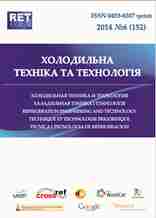CRYOSURGICAL APPARATUSES COLD ACCUMULATORS
DOI:
https://doi.org/10.15673/0453-8307.6/2014.29404Keywords:
Cryosurgery – Cryoprobe – Heat pipe – Nitrogen – Ethanol – Phase transition.Abstract
Cryosurgical apparatuses exploiting a phase transition “liquid – vapour” of the working agent (nitrogen apparatus) and phase transition “liquid – solid state” of the working agent (ethanol apparatus) are considered in the paper. Schematics and design of the apparatuses with the heat load input directly to the operating nozzle/cap, through a special cryoprobe which was manufactured as a solid copper rode and in the form of heat pipe. The main distinctions of those apparatus imply that in the nitrogen apparatus the working agent (N2) has to be replaced after every surgery unlike the ethanol apparatus where total amount of the working agent (ethanol) is steady and has to be just refreezed after surgery. Advantages and shortcomings of the considered designs are discussed. The prospects for the reported designs of the cryosurgical apparatus have been pointed out.
References
REFERENCES
Bondarenko V.L., Naer V.A., Simonenko Ju.M. Cryogenics in modern medicine // Kholodilnaya tekhnika i tekhnologiya.[Refrigeration Engineering and Technology]. – 2007. – № 2. – P. 1-7. (Rus.).
Naer V.A., Rozhentsev А.V., Hasan Vesam Anvar Ali. Working agents with phase transition liquid-solid-liquid for cryosurgical apparatus // Kholodilnaya tekhnika i tekhnologiya.[Refrigeration Engineering and Technology]. – 2013. – № 6. – P. 16-23. (Rus.).
V. Naer, A. Rozhentsev. Application of hydro-carbon mixtures in small refrigetrating and cryogenic machines. International Journal of Refrigeration, 27. – 2004 – p. 484-491.
DOI: 10.1016/S0140-7007(01)00092-5


